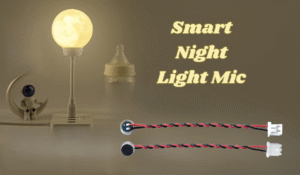Les microphones à électret offrent les avantages d'une sensibilité élevée, d'une taille compacte et d'une faible consommation d'énergie. Cependant, leur utilisation nécessite le respect de normes et d'exigences spécifiques. La compréhension de ces normes est essentielle pour sélectionner efficacement le microphone adapté à votre application. Cet article sert de guide détaillé pour vous aider à choisir la sensibilité de microphone appropriée pour différents scénarios.

Table des matières
Sensibilité du microphone
Qu'est-ce que la sensibilité du microphone
La sensibilité d'un microphone fait référence à la tension de sortie d'un transducteur sous une certaine intensité sonore, indiquant l'efficacité avec laquelle il convertit la pression sonore en signal électrique. Elle est généralement mesurée en dB, représentant la tension de sortie lorsqu'elle est soumise à un niveau de pression sonore standard.
Comment tester la sensibilité du microphone
La sensibilité est testée en appliquant un niveau de pression acoustique de 1 Pa (94 dB) et en mesurant la tension de sortie en dBV. Par exemple, un microphone avec une sensibilité de -30 dBV/Pa est beaucoup plus sensible qu'un microphone avec -42 dBV/Pa.
Facteurs influençant la sensibilité du microphone
La sensibilité dépend non seulement du microphone lui-même, mais également du circuit d'application, notamment de la résistance de charge (RL). Une sensibilité plus élevée est généralement souhaitée, mais elle doit être équilibrée pour éviter toute distorsion.
Adaptation de la sensibilité du micro au gain de l'ampli
Lors de la sélection d'un microphone, tenez compte du gain de l'amplificateur :
- Amplificateurs à gain élevé:Utilisez des microphones avec une sensibilité plus faible (environ -40 dB).
- Amplificateurs à faible gain:Utilisez des microphones avec une sensibilité plus élevée (environ -30 dB).
Scénarios d'application
Enceintes intelligentes
Les appareils comme Amazon Echo et Google Home nécessitent une sensibilité élevée pour une reconnaissance précise des commandes vocales. Une sensibilité d'environ -30 dB est recommandée pour garantir une interaction claire et fiable avec l'utilisateur.
Caméras de sécurité
Une sensibilité élevée, d'environ -25 dB, est essentielle pour une capture sonore claire, en particulier sur de longues distances ou dans des positions élevées. Cela garantit que même les sons faibles sont captés, offrant de meilleures capacités de surveillance.
Lumières contrôlées par le son
Pour les éclairages contrôlés par le son, la sensibilité est cruciale, mais la réponse en fréquence et la distorsion sont moins importantes. Une sensibilité supérieure à -30 dB est recommandée pour garantir une activation fiable.
Enregistrement de la conférence
Une sensibilité moyenne à élevée, de l'ordre de -32 dB à -35 dB, est adaptée pour capturer un son clair lors de réunions et de conférences. Cet équilibre permet d'éviter les déclenchements intempestifs du bruit tout en garantissant que tous les intervenants sont entendus clairement.
Réseaux de microphones
Les réseaux de microphones doivent présenter une bonne cohérence avec une marge d'erreur inférieure à 2 dB. Cela garantit une capture audio uniforme dans les salles de conférence et les grands halls, améliorant ainsi la qualité sonore globale et la fiabilité du réseau.
Jouets à commande sonore
Les exigences ne sont pas strictes pour les jouets à commande sonore ; une sensibilité d'environ -35 dB est suffisante pour répondre aux commandes sonores de base sans être trop sensible au bruit de fond.
Microphones de karaoké
Pour les microphones de karaoké, une sensibilité moyenne d'environ -40 dB est recommandée pour éviter les problèmes de retour et garantir une meilleure expérience de chant. Ce niveau permet d'équilibrer la qualité du son et la prévention du retour.
Conclusion
La sensibilité du microphone est cruciale pour diverses applications, allant des enceintes intelligentes aux caméras de sécurité et à l'enregistrement de conférences. Comprendre les normes de sensibilité et choisir le bon microphone peut grandement améliorer les performances audio dans différents scénarios. Une prise en compte attentive du gain de l'amplificateur et des exigences de l'application vous aidera à sélectionner le microphone le plus adapté, garantissant des performances optimales et la satisfaction de l'utilisateur.


